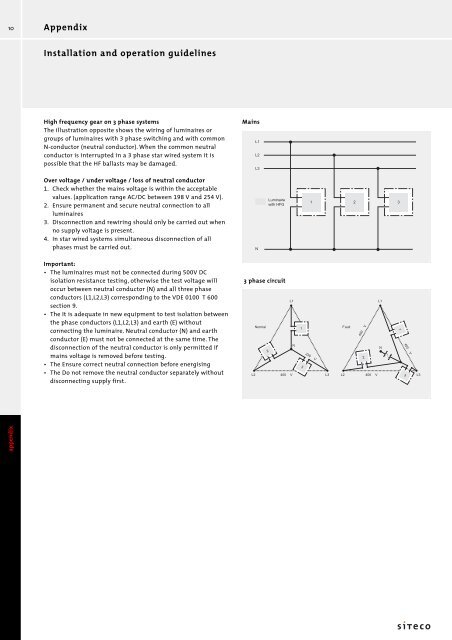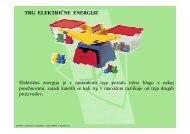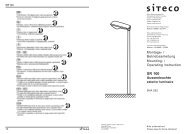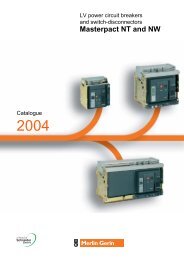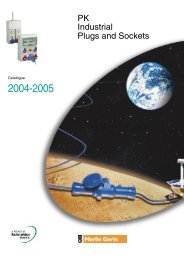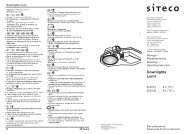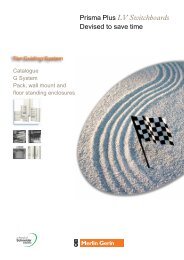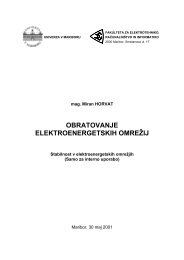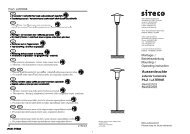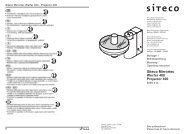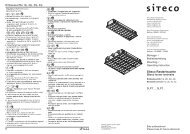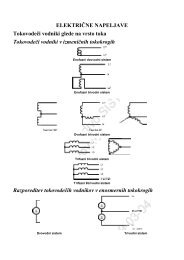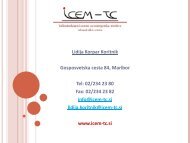- Page 1 and 2:
1 Your contact at Siteco: Name : De
- Page 3 and 4:
3 “Coming together is the start,
- Page 5 and 6:
5 about us Uplights, desk-top and w
- Page 7 and 8:
7 about us 1 2 3 4 5 6 7 8 However,
- Page 9 and 10:
9 about us 1 2 3 4 5 6 7 8 Second,
- Page 11 and 12:
11 about us Whether used as desk-to
- Page 13 and 14:
13 about us 1 2 3 4 5 6 7 8 Siteco
- Page 15 and 16:
15 Downlights for all occasions: th
- Page 17 and 18:
17 about us 1 2 3 4 The starry sky
- Page 19 and 20:
19 about us 1 2 3 4 5 6 As in 1001
- Page 21 and 22:
21 about us 1 vibration load and ex
- Page 23 and 24:
23 about us 1 2 3 4 5 6 7 8 Lightin
- Page 25 and 26:
25 Lighting refurbishment in the of
- Page 27 and 28:
27 about us 1 2 3 4 5 6 7 8 9 10 11
- Page 29 and 30:
29 Welcome to Siteco. about us 1 2
- Page 31 and 32:
31 shopping public sports about us
- Page 33 and 34:
Uplights, desktop and wall luminair
- Page 35 and 36:
Uplights, desktop and wall luminair
- Page 37 and 38:
Uplights and wall luminaires, Wave
- Page 39 and 40:
Wave desktop luminaires 7 with ELDA
- Page 41 and 42:
Mobile lighting system in 3 version
- Page 43 and 44:
Mobile lighting system in 2 version
- Page 45 and 46:
Mobile lighting systems, uplights,
- Page 47 and 48:
15 1
- Page 49 and 50:
Downlights 1 2 Siteco Lunis_S 2/4 N
- Page 51 and 52:
Downlights 3 2 Surface mounted down
- Page 53 and 54:
Surface mounted downlights Lunis_S
- Page 55 and 56:
New design high value surface mount
- Page 57 and 58:
Recessed downlights Lunis_E 9 Lunis
- Page 59 and 60:
Recessed downlights for premium ins
- Page 61 and 62:
Recessed downlights for premium ins
- Page 63 and 64:
Recessed downlights for premium ins
- Page 65 and 66:
Recessed downlights for premium ins
- Page 67 and 68:
Lunis_E 19 Optical and decorative a
- Page 69 and 70:
Recessed downlights Lunis® 21 On c
- Page 71 and 72:
Recessed downlights for compact flu
- Page 73 and 74:
Recessed downlights for compact flu
- Page 75 and 76:
] Recessed downlights for compact f
- Page 77 and 78:
Recessed downlights for compact flu
- Page 79 and 80:
Recessed downlights for compact flu
- Page 81 and 82:
Siteco Lunis® 33 Optical and decor
- Page 83 and 84:
Recessed downlights HIGHLIGHT 35 2
- Page 85 and 86:
Recessed downlights with advanced l
- Page 87 and 88:
Recessed downlights with advanced l
- Page 89 and 90:
Recessed downlights with advanced l
- Page 91 and 92:
Recessed downlights with advanced l
- Page 93 and 94:
Downlights 45 Mounting Accessories
- Page 95 and 96:
Downlights 47 Electrical accessorie
- Page 97 and 98:
Downlights 49 Dimensions 5LR 514 5L
- Page 99 and 100:
Downlights 51 2
- Page 101 and 102:
Secondary systems 1 SiLUNA Secondar
- Page 103 and 104:
SiLUNA secondary surface and recess
- Page 105 and 106:
Secondary surface luminaires, SiLUN
- Page 107 and 108:
Secondary recessed luminaires, SiLU
- Page 109 and 110:
Recessed luminaires, SiLUNA 9 Overv
- Page 111 and 112:
SiLUNA secondary surface and recess
- Page 113 and 114:
Secondary reflector systems 13 3 Sy
- Page 115 and 116:
Secondary reflector system 15 SiNAR
- Page 117 and 118:
Secondary reflector system 17 SiSTA
- Page 119 and 120:
Secondary reflector system 19 SiCOM
- Page 121 and 122:
Secondary reflector system 21 SiCOM
- Page 123 and 124:
Secondary reflector system 23 Paral
- Page 125 and 126:
Secondary reflector system 25 5NW 1
- Page 127 and 128:
Secondary reflector system 27 SiSTA
- Page 129 and 130:
Secondary reflector system 29 5NW 1
- Page 131 and 132:
Secondary reflector system 31 5NW 1
- Page 133 and 134:
0 Secondary reflector system 33 Dim
- Page 135 and 136:
Secondary Reflector System 35 Dimen
- Page 137 and 138:
Secondary Reflector System 37 Dimen
- Page 139 and 140:
1 SiTECO Orbiter 4/4 Wave 4/6 SiFOR
- Page 141 and 142:
Pendant luminaires, SiTECO Orbiter
- Page 143 and 144:
Pendant luminaires, SiTECO Orbiter
- Page 145 and 146:
Pendant luminaires, Wave 7 ELDACON
- Page 147 and 148:
Pendant luminaires, SiTECO Orbiter
- Page 149 and 150:
Pendant luminaires, SiFORM for indi
- Page 151 and 152:
Pendant luminaires, SiFORM for cont
- Page 153 and 154:
Pendant luminaires, SiFORM for indi
- Page 155 and 156:
Pendant luminaires, SiFORM for indi
- Page 157 and 158:
Pendant luminaires, SiFORM for indi
- Page 159 and 160:
Pendant luminaires, SiFORM for indi
- Page 161 and 162:
Pendant luminaires, SiFORM for indi
- Page 163 and 164:
Pendant luminaires, SiFORM for indi
- Page 165 and 166:
Pendant luminaires, SiFORM for indi
- Page 167 and 168:
Pendant luminaire SiFORM 29 Orderin
- Page 169 and 170:
Pendant luminaire SiFORM 31 Special
- Page 171 and 172:
Pendant luminaire SiFORM 33 Dimensi
- Page 173 and 174:
Surface and pendant luminaires Site
- Page 175 and 176:
Surface and pendant luminaires, Sit
- Page 177 and 178:
Surface and pendant luminaires, Sit
- Page 179 and 180:
Surface and pendant luminaires, Sit
- Page 181 and 182:
Surface and pendant luminaires, Sit
- Page 183 and 184:
Surface and pendant luminaires, Sit
- Page 185 and 186:
Surface and pendant luminaires, Sit
- Page 187 and 188:
Surface and pendant luminaires, Sit
- Page 189 and 190:
Surface and pendant luminaires Site
- Page 191 and 192:
Surface and pendant luminaires, Sit
- Page 193 and 194:
Surface and pendant luminaires, Sit
- Page 195 and 196:
Surface and pendant luminaires, Sit
- Page 197 and 198:
Surface and pendant luminaires, Sit
- Page 199 and 200:
Surface and pendant luminaires, Sit
- Page 201 and 202:
Surface and pendant luminaires, Sit
- Page 203 and 204:
Surface and pendant luminaires, Sit
- Page 205 and 206:
Surface and pendant luminaires, Sit
- Page 207 and 208:
Surface and pendant luminaires, Sit
- Page 209 and 210:
Surface and pendant luminaires, Sit
- Page 211 and 212:
Surface and pendant luminaires, Sit
- Page 213 and 214:
Surface and pendant luminaires, Sit
- Page 215 and 216:
Surface and pendant luminaires, Sit
- Page 217 and 218:
Surface and pendant luminaires, Sit
- Page 219 and 220:
Surface and pendant luminaires, Sit
- Page 221 and 222:
Surface and pendant luminaires, Sit
- Page 223 and 224:
Surface and pendant luminaires, Sit
- Page 225 and 226:
Surface and pendant luminaires, Sit
- Page 227 and 228:
Surface and pendant luminaires, Sit
- Page 229 and 230:
Surface and pendant luminaires, Sit
- Page 231 and 232:
Surface and pendant luminaires, Sit
- Page 233 and 234:
Surface ceiling washer 95 4 SiLING
- Page 235 and 236:
Surface luminaire, SiLING 97 Asymme
- Page 237 and 238:
Surface luminaire, Ceilingwasher 99
- Page 239 and 240:
Surface luminaire, Ceilingwasher 10
- Page 241 and 242:
Recessed luminaires 1 5 Recessed lu
- Page 243 and 244:
Recessed luminaires 3 5 With the Si
- Page 245 and 246:
Recessed luminaires 5 Recessed lumi
- Page 247 and 248:
Recessed luminaires Siteco LF7 7 5
- Page 249 and 250:
Refurbishment luminaire, Siteco LF7
- Page 251 and 252:
Refurbishment luminaire, Siteco LF7
- Page 253 and 254:
Refurbishment luminaire, Siteco LF7
- Page 255 and 256:
Refurbishment luminaire, Siteco LF7
- Page 257 and 258:
Siteco LF7 17 Dimensions Siteco LF7
- Page 259 and 260:
Siteco LF7 19 Dimensions Three lamp
- Page 261 and 262:
Recessed luminaires, Siteco LF1 21
- Page 263 and 264:
Recessed luminaires, Siteco LF1 23
- Page 265 and 266:
Recessed luminaires, Siteco LF1 25
- Page 267 and 268:
Recessed luminaires, Siteco LF1 27
- Page 269 and 270:
Recessed luminaires, Siteco LF1 29
- Page 271 and 272:
Recessed luminaires, Siteco LF1 31
- Page 273 and 274:
Recessed luminaires, Siteco LF1 33
- Page 275 and 276:
Recessed luminaires, Siteco LF1 35
- Page 277 and 278:
Recessed luminaires, Siteco LP1/LP7
- Page 279 and 280:
Recessed luminaires, Siteco LP1 39
- Page 281 and 282:
Recessed luminaires, Siteco LP1 41
- Page 283 and 284:
Recessed luminaires, Siteco LP1/LP7
- Page 285 and 286:
Recessed luminaires, Siteco LQ1 45
- Page 287 and 288:
Recessed luminaires, Siteco LP1 47
- Page 289 and 290:
Recessed luminaires, Siteco LP1/LP7
- Page 291 and 292:
Recessed luminaires, Siteco LP1/LP7
- Page 293 and 294:
Recessed luminaires, Siteco LP1/LP7
- Page 295 and 296:
Recessed ceiling washer 55 5 Ceilin
- Page 297 and 298:
Recessed ceiling washer 57 Matt fin
- Page 299 and 300:
Recessed ceiling washer 59 Dimensio
- Page 301 and 302:
Air-handling recessed luminaires, S
- Page 303 and 304:
Air handling recessed luminiares 3
- Page 305 and 306:
Air-handling recessed luminaires, S
- Page 307 and 308:
Air-handling recessed luminaires, S
- Page 309 and 310:
Air-handling recessed luminaires, S
- Page 311 and 312:
Air-handling recessed luminaires, S
- Page 313 and 314:
Air-handling recessed luminaires, S
- Page 315 and 316:
Trunking systems 1 Hexal-a and Hexa
- Page 317 and 318:
Hexal trunking systems 3 7 Hexal sy
- Page 319 and 320:
Hexal-a and Hexal-s trunking system
- Page 321 and 322:
Hexal-a trunking system for T5 fluo
- Page 323 and 324:
Hexal-a trunking system for T5 fluo
- Page 325 and 326:
Hexal-a trunking system for T8 fluo
- Page 327 and 328:
Hexal-a trunking system for T8 fluo
- Page 329 and 330:
Hexal-a trunking system for T8 fluo
- Page 331 and 332:
Hexal-a trunking system for T8 fluo
- Page 333 and 334:
Hexal-a trunking system for T8 fluo
- Page 335 and 336:
Hexal-a and Hexal-s trunking system
- Page 337 and 338:
Hexal-a and Hexal-s trunking system
- Page 339 and 340:
DUS IP20 trunking system 25 Overvie
- Page 341 and 342:
DUS IP20 trunking system 27 Overvie
- Page 343 and 344:
DUS IP20 trunking system 29 Trunkin
- Page 345 and 346:
DUS IP20 trunking system 31 Battens
- Page 347 and 348:
DUS IP20 trunking system 33 Emergen
- Page 349 and 350:
DUS IP20 trunking system 35 Trough
- Page 351 and 352:
DUS IP20 trunking system 37 Perfora
- Page 353 and 354:
DUS IP20 trunking system 39 Alumini
- Page 355 and 356:
DUS IP20 trunking system 41 Alumini
- Page 357 and 358:
DUS IP20 trunking system 43 Optical
- Page 359 and 360:
DUS IP20 trunking system 45 Optical
- Page 361 and 362:
DUS IP20 trunking system 47 Accesso
- Page 363 and 364:
DUS IP20 trunking system 49 Mountin
- Page 365 and 366:
DUS IP20 trunking system 51 Trunkin
- Page 367 and 368:
DUS IP20 trunking system 53 Dimensi
- Page 369 and 370:
Batten Luminaires 55 Batten luminai
- Page 371 and 372:
Batten luminaires for T5 and T8 lam
- Page 373 and 374:
Batten luminaires, DUS, for T8 lamp
- Page 375 and 376:
Batten luminaires, DUS, for T8 lamp
- Page 377 and 378:
Batten luminaires, DUS, for T8 lamp
- Page 379 and 380:
Batten luminaires, DUS, for T8 lamp
- Page 381 and 382:
Special clean area luminaire IP20 6
- Page 383 and 384:
Batten luminaires 69 Dimensions H L
- Page 385 and 386:
Surface diffuser luminaires 1 Europ
- Page 387 and 388:
Surface diffuser luminaire, Europle
- Page 389 and 390:
Surface diffuser luminaire, Europle
- Page 391 and 392:
Surface diffuser luminaire, Europle
- Page 393 and 394:
Surface diffuser luminaire, Europle
- Page 395 and 396:
Surface diffuser luminaire, Europle
- Page 397 and 398:
Surface diffuser luminaires, Europl
- Page 399 and 400:
l Surface diffuser luminaires 15 Di
- Page 401 and 402:
Recessed diffuser luminaire, SiLUZE
- Page 403 and 404:
Recessed diffuser luminaire, SiLUZE
- Page 405 and 406:
Damp proof luminaires 1 Wherever th
- Page 407 and 408:
Damp proof luminaires 3 FR500 Damp
- Page 409 and 410:
Damp proof diffuser luminaire, FR50
- Page 411 and 412:
Damp proof diffuser luminaire, FR20
- Page 413 and 414:
Damp proof diffuser luminaire, FR10
- Page 415 and 416:
Damp proof diffuser luminaire, FR10
- Page 417 and 418:
Damp proof diffuser luminaires, FR5
- Page 419 and 420:
Damp proof diffuser luminaire, Mons
- Page 421 and 422:
Damp proof diffuser luminaire, Mons
- Page 423 and 424:
Damp proof diffuser luminaire, Mons
- Page 425 and 426:
Damp proof diffuser luminaire, Mons
- Page 427 and 428:
Damp proof diffuser luminaire, Mons
- Page 429 and 430:
Damp proof diffuser luminaire, SiPL
- Page 431 and 432:
Damp proof diffuser luminaire, SiPL
- Page 433 and 434:
Open lamp distribution damp-proof l
- Page 435 and 436:
Open lamp distribution damp-proof l
- Page 437 and 438:
Damp proof luminaire 33 Dimensions
- Page 439 and 440:
H Damp proof luminaire 35 Dimension
- Page 441 and 442:
Mounting rails 37 DUS trunking, gal
- Page 443 and 444:
Mounting rails 39 Mounting rail, pl
- Page 445 and 446:
High bay luminaires 1 Luminaire sys
- Page 447 and 448:
High bay luminaires 3 High bay lumi
- Page 449 and 450:
High bay luminaires 5 with paraboli
- Page 451 and 452:
High bay luminaires 7 Accessories H
- Page 453 and 454:
High bay reflector luminaires ASTER
- Page 455 and 456:
High bay reflector luminaire, ASTER
- Page 457 and 458:
High bay reflector luminaire, ASTER
- Page 459 and 460:
High bay reflector luminaire, ASTER
- Page 461 and 462:
High bay reflector luminaire, ASTER
- Page 463 and 464:
High bay reflector luminaire, ASTER
- Page 465 and 466:
High bay luminaires HS100 21 10
- Page 467 and 468:
High bay reflector luminaire, HS 10
- Page 469 and 470:
High bay luminaires, HS 100 25 with
- Page 471 and 472:
High bay reflector luminaire, HS 10
- Page 473 and 474:
37 H High bay reflector luminaire,
- Page 475 and 476:
Compact reflector luminaire 31 Comp
- Page 477 and 478:
Compact reflector luminaires 33 wit
- Page 479 and 480:
] Compact reflector luminaires, bal
- Page 481 and 482:
Floodlights, SiCOMPACT A MIDI 37 As
- Page 483 and 484:
Floodlights, SiCOMPACT A MINI 39 As
- Page 485 and 486:
Floodlights, SiCOMPACT A MINI 41 Di
- Page 487 and 488: 43 10
- Page 489 and 490: Specific customer lighting solution
- Page 491 and 492: Specific customer lighting solution
- Page 493 and 494: AVION suspended luminaire 5 The des
- Page 495 and 496: System Esline - innovation in light
- Page 497 and 498: Wing luminaire - soft light with ai
- Page 499 and 500: Indirect channel Luminaire with dec
- Page 501 and 502: One luminaire - three light moods,
- Page 503 and 504: Circ - the round, all around glare
- Page 505 and 506: H Linear curved reflector with VDU
- Page 507 and 508: Compact surface mounted ring lens d
- Page 509 and 510: ENOMIS - Semi-recessed secondary lu
- Page 511 and 512: LUMOS - a new light for the office
- Page 513 and 514: System STREXX, the intelligent modu
- Page 515 and 516: Ceiling Washer - asymmetrical distr
- Page 517 and 518: Siluna VT - recessed luminaire with
- Page 519 and 520: Daylight systems 31 General 32 Micr
- Page 521 and 522: Daylight systems 33 The natural com
- Page 523 and 524: Daylight systems 35 Micro sun sheil
- Page 525 and 526: Daylight systems 37 Moveable prism
- Page 527 and 528: Daylight systems 39 Static prism sy
- Page 529 and 530: Appendix 1 Luminaire technical data
- Page 531 and 532: Appendix 3 Luminaire technical data
- Page 533 and 534: Appendix 5 Light planning Project D
- Page 535 and 536: Appendix 7 Optical data and termino
- Page 537: Appendix 9 Installation and operati
- Page 541 and 542: Appendix 13 Control gear Benefits o
- Page 543 and 544: Appendix 15 Power factor correction
- Page 545 and 546: Appendix 17 Refurbishment Saving is
- Page 547 and 548: Appendix 19 Icon Legend Maximum con
- Page 549 and 550: Appendix 21 Icon Legend Lamps TC-T
- Page 551 and 552: Appendix 23 lamp technical data Cat
- Page 553 and 554: Appendix 25 Index O Opal diffusers
- Page 555 and 556: Appendix 27 Code Chapter/Page Code
- Page 557 and 558: Appendix 29 Code Chapter/Page Code
- Page 559 and 560: Appendix 31 Code Chapter/Page Code
- Page 561 and 562: Appendix 33 Our Manufacturing and D


